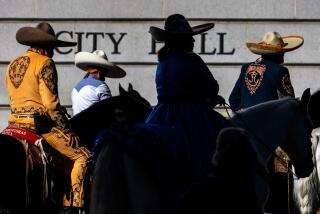Spain: Catalonia grapples with proposal to ban bullfighting
Reporting from Barcelona, Spain — Fans laid on a hero’s welcome when Jose Tomas made a triumphal return to professional bullfighting in Barcelona three years ago, ending a much-lamented retirement.
But when Tomas arrives here next month for another comeback of sorts — one of his first engagements since being badly gored in Mexico in April — the celebrated matador could find himself in quite a different position: as an outlaw.
Regional lawmakers are expected to decide soon whether to abolish bullfighting once and for all here in Catalonia. Signs indicate they’ll vote yes, which would make this northeastern coastal region the first on the Spanish mainland to approve such a ban.
It’s about time, backers say, that Catalonia got rid of a cruel and bloody sport that essentially makes a virtue of the torture and killing of a captive animal.
But opponents of the ban suspect the stated concern for animal welfare is a smokescreen for a more political aim: thumbing a nose at the rest of Spain, in an assertion of Catalonian identity and nationalist aspiration.
The debate has stoked regional tensions in a country where such divisions can be a combustible mix, occasionally transmuting into separatist violence — for example, in the Basque area. Although Catalonia doesn’t have the same history of violent separatism, plenty of people here see themselves as different from “the Spanish” and yearn for independence.
The anti-bullfighting campaign has sparked an angry backlash in Madrid, Valencia and Murcia, whose governments have moved to declare the sport a cultural landmark, a status that could give organizers tax breaks and other special protections.
“Bullfighting was a source of inspiration for Goya, Picasso, Garcia Lorca, Hemingway and Orson Welles,” Esperanza Aguirre, the head of Madrid’s regional government, told reporters recently, posing with a pink matador’s cape. “It’s an art that has been in our culture for as long as we can remember.”
Bullfight reviews routinely turn up on the arts pages of Spanish newspapers, and when a dashing torero like Tomas steps into the arena, exhibiting a daredevil yet classical style seldom seen anymore, aficionados speak in hushed tones about a mystical experience.
Animal rights activists have little patience for talk of culture and tradition. To them, the dashing gold matador outfits and the romantic aura built up around bullfighting are merely ways of dressing up ritualized cruelty.
“We think it’s a shame for a country to have a symbol like that,” said Manel Macia Gallemi of the organization Prou (“Enough” in Catalan), which has led the drive for a ban. “Spanish traditional culture has flamenco and other things you don’t have to be ashamed of.”
Macia Gallemi noted that opposition to bullfighting isn’t just a Catalonian phenomenon. In Madrid, a bullfighting protest in March drew thousands of demonstrators toting placards with slogans such as “Torture is not culture.”
And plenty of Catalonians themselves have been enthusiastic followers of bullfighting.
“It’s true, in the past Catalonia liked bullfighting more than now. My grandfather was an example,” Macia Gallemi said. “It was a kind of popular entertainment, because they had no other distractions.”
But society and notions of ethical treatment of animals have moved on, and bullfighting should follow activities such as bear-baiting to the dustbin of history, activists say.
Their petition to ban the sport drew 180,000 signatures. That was three times more than the number necessary to land the petition in the Catalonian regional assembly, forcing lawmakers to vote on whether to initiate legislation.
The issue was so sensitive that for the first time in memory, lawmaker David Perez said, the chamber turned off the electronic voting board so that “no one would feel scared.”
Perez, a member of the left-leaning Socialist Party, opposes abolition.
“It’s unfair to ban everything that you personally don’t like,” he said.
Plus, the proposal to end bullfighting ignores other traditions that could also be deemed cruel, including the practice during some rural festivals of attaching flaming torches to bulls’ horns.
To Perez, that silence is proof of inconsistency, and an ulterior motive.
“It wasn’t a question of animal suffering or animal abuse. It was a question of Catalan identity,” he said.
In fact, the real enemy of bullfighting may not be animal rights activists or Catalonian nationalists but time. Except for the adoring crowds that Tomas, the star matador, can draw, the audience for bullfights has been steadily dwindling. Barcelona’s main bullring, the Plaza Monumental, often struggles to fill even half its seats.
The coup de grace for bullfighting may therefore end up being delivered not by outright hostility but, instead, by casual indifference.
More to Read
Sign up for Essential California
The most important California stories and recommendations in your inbox every morning.
You may occasionally receive promotional content from the Los Angeles Times.











